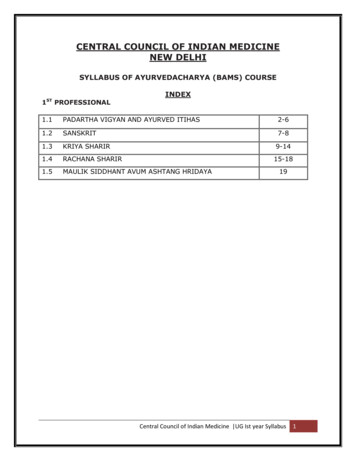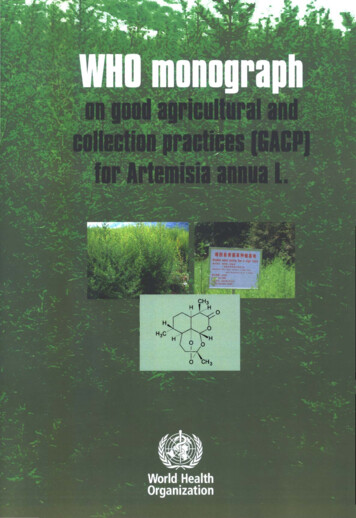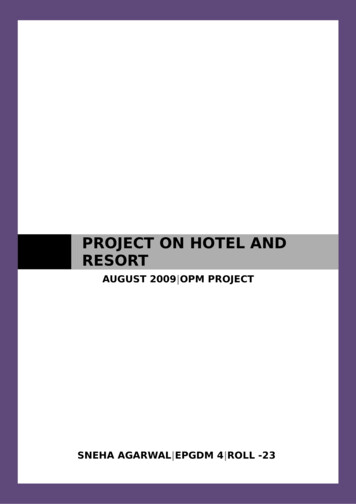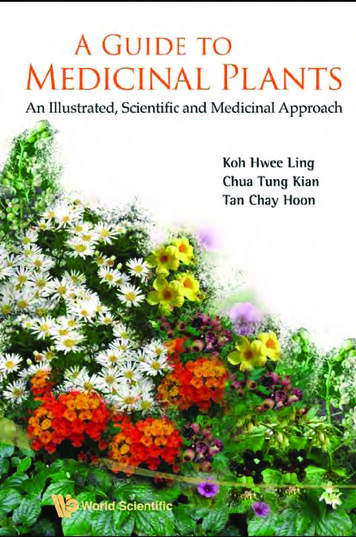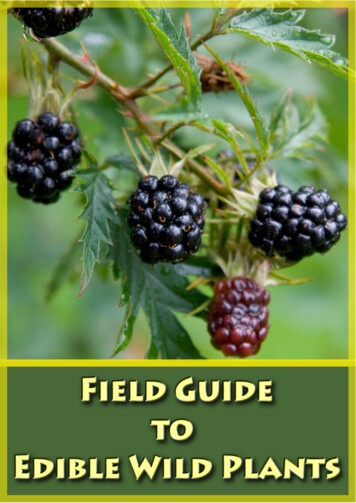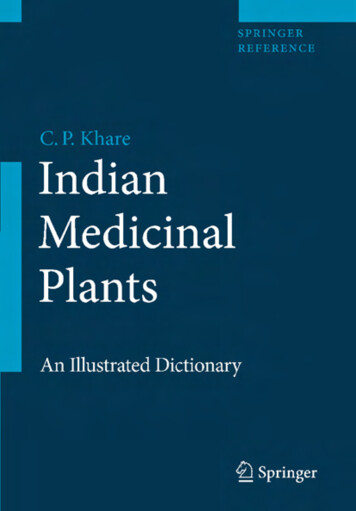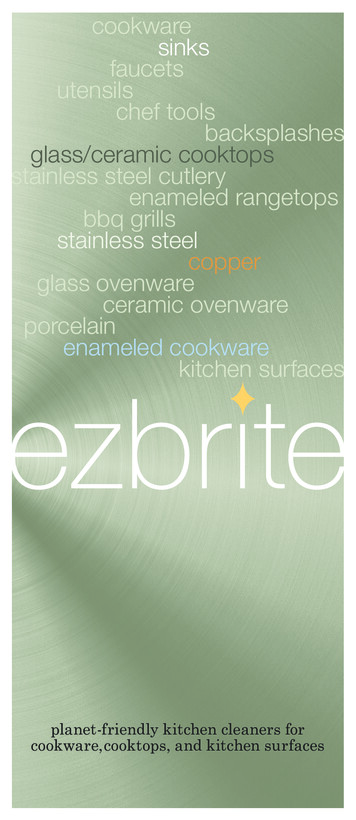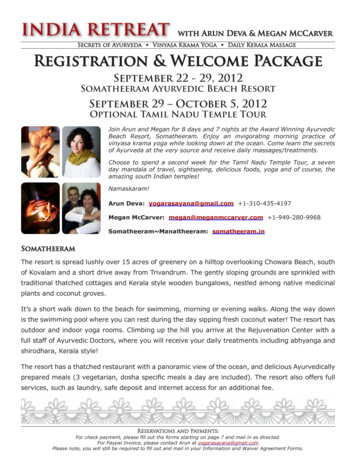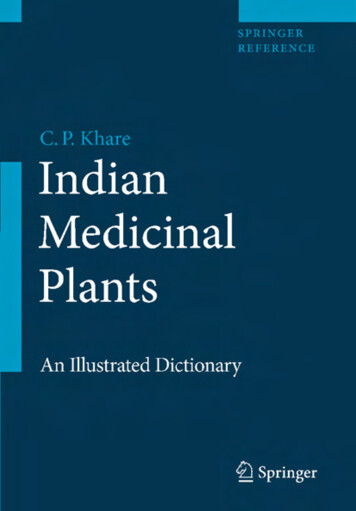
Transcription
Indian Medicinal Plants
C.P. Khare (Ed.)Indian Medicinal PlantsAn Illustrated DictionaryWith Pictures of Crude Herbs123
AuthorC.P. KhareB- / , Janak PuriNew Delhi- Indiachandrma khare@yahoo.comLibrary of Congress Control Number: ISBN: - - - - Springer-Verlag Berlin/Heidelberg Springer Science Business Media, LLC.All rights reserved. This work may not be translated or copied in whole or in part without thewritten permission of the publisher (Springer Science Business Media, LLC., Spring Street,New York, NY , USA), except for brief excerpts in connection with reviews or scholarlyanalysis. Use in connection with any form of information storage and retrieval, electronic adaptation, computer software, or by similar or dissimilar methodology now known or hereafterdeveloped is forbidden. The use in this publication of trade names, trademarks, service marks,and similar terms, even if they are not identified as such, is not to be taken as an expression ofopinion as to whether or not they are subject to proprietary rights.springer.comPrinted on acid-free paperSPIN: —
Dedicated tothe distinguished scientistDr. A. P. J. Adbul Kalamwho revived the glory ofIndian medicinal and aromatic plantsin the Rashtrapati Bhawan.
Guiding FactorsFirst of all, let me acknowledge with gratitude the contribution of the followingreference works which synchronised the synonyms and medicinal properties ofIndian medicinal plants: A Catalogue of Indian Synonyms of the Medicinal Plants of India by MoodeenSheriff ( ). (The first exhaustive compilation of synonyms of Indian medicinal plants in regional languages, besides Latin and English). Indian Medicinal Plants by Lt. Col. K.R. Kirtikar and Major B.D. Basu ( ). Glossary of Indian Medicinal Plants by Col. Sir Ram Nath Chopra et al. (CSIR, ). Useful Plants of India (CSIR, ; based on The Wealth of India series, Vol. I , Vol. XI ). Dictionary of Indian Medicinal Plants by Akhtar Husain et al. (CIMAP, ).Based on this legacy, Indian Medicinal Plants. An Illustrated Dictionary is aimedat bringing out an updated Active Study Dictionary of plant sources of Indianmedicine, as a companion volume of my earlier book Encyclopedia of IndianMedicinal Plants/Indian Herbal Remedies, published by Springer.Ayurvedic synonyms have been selected from the following sources: The Ayurvedic Pharmacopoeia of India (Vol. I to IV). Standard Nomenclature of Ayurvedic Medicinal Plants (CCRAS, ). Medicinal Plants used in Ayurveda (Rashtriya Ayurveda Vidyapeeth/ NationalAcademy of Ayurveda, ). Plants of Sharangadhara Samhita by Prof. K.C. Chunekar and Dr. K. Pondel(National Academy of Ayurveda, ).
VIIIGuiding Factors Plants of Bhava Prakash by Prof. K.C. Chunekar and Dr. N.P. Hota (NationalAcademy of Ayurveda, ). Central Council for Research in Ayurveda and Siddha (CCRAS). Publishedliterature. Dravyagun Vigyaan, Vol. II (Hindi) by Dr. Priyavrata Sharma ( ).Unani synonyms have been selected from the following sources: The National Formulary of Unani Medicine. Central Council for Research in Unani Medicine (CCRUM). Published literature. Unani Dravyagunaadarsh (Hindi) by Daljit Singh (Ayurvedic and Tibbi Academy, Uttar Pradesh, Lucknow, ).Siddha/Tamil synonyms have been selected from the following sources: Formulary of Siddha Medicine. (Indian Medical Practitioners’ CooperativePharmacy and Store Ltd., IMPCOPS, Chennai). The Wealth of India (Vol. II to XI). Dictionary of Indian Medicinal Plants (CIMAP). The Ayurvedic Pharmacopoeia of India (Vol. I to IV). Central Council for Research in Ayurveda and Siddha (CCRAS). Publishedliterature.The medicinal plants shortlisted by the National Academy of Ayurveda andthe department of Indian Systems of Medicine (AYUSH) have been included inthe book.Key applications of medicinal plants are based on the following sources: German Commission E monographs. ESCOP monographs. WHO monographs. Indian Herbal Pharmacopoeia. The Ayurvedic Pharmacopoeia of India (Vol. I to IV) for traditionally recognisedapplications.
Guiding Factors The British Herbal Pharmacopoeia. The British Herbal Compendium. Natural Medicines Comprehensive Database, .For further study, all major findings and leads, including references to research documents and journals, can be reached through the following books (insequence): The Wealth of India First Supplement Series (Vol. I to V). The Wealth of India original series (Vol. II to XI and revised Vol. to ). Compendium of Indian Medicinal Plants (Vol. I to V, CDRI). Potter’s New Cyclopaedia of Botanical Drugs and Preparations ( edn). Natural Medicines Comprehensive Database, . PDR for Herbal Medicines, . The Treatise on Indian Medicinal Plants (Vol. I to VI). Additional sources, as cited at appropriate places.Dosage of crude herbs is based on the recommendations of The AyurvedicPharmacopoeia of India (Vol. I to IV) and Standard Nomenclature of AyurvedicMedicinal Plants (CCRAS).Roman spellings of Ayurvedic synonyms, introduced for the first time byRashtriya Ayurveda Vidyapeeth (National Academy of Ayurveda), New Delhi , have been followed. Asiatic Society’s markings are now obsolete. Thetext has been formatted following the style-manual of The Wealth of India seriesof CSIR.Detailed references of research journals are beyond the purview of this project.The text is based on authentic treatises which are the outcome of scientificscreening and critical evaluation by eminent scholars. As I have already indicated,readers, if they so desire, can always refer back to a particular research papercited in the original source. I did not follow the trend of enumerating researchpapers which were not actually consulted by me. Researchers should consult theDatabase on Medicinal Plants used in Ayurveda series (CCRAS) and Reviews onIndian Medicinal Plants series (ICMR) for detailed bibliography.All Indian common names have been spelled according to their actual pronunciation. The way was shown by the National Academy of Ayurveda byintroducing aa in the spellings. In The Review of Natural Products (Facts andComparisons) edition., Khat, Chaat, Chat, qaad, jaad and Miraa have beenIX
XGuiding Factorsincluded among the common names of Catha edulis, while the common nameof Gymnema sylvestre is spelled as Gurmar instead of Gurmaar. Perhaps theactual pronunciation was not known to the editors. In India, O is pronouncedin a specific ascent, as in Om, that is the reason uu is used instead of oo. Similarly, Sanskrit synonyms end with a, that is why aa is used for facilitating properpronunciation. These changes have been included so that Indian names arepronounced correctly.A few words of gratitude. Dr. V.K. Agarwal Ph. D. (Medicinal Chemistry), whowas the senior editor (chemistry and pharmacology) of The Wealth of India seriesfor years, reviewed the entire text. He remained closely associated with all myprojects and deserves much more than a few formal words of thanks. Sarita Joshi,my research associate, bore the brunt of the workload throughout the difficultphases of the project. For this she also deserves a special mention.Finally, I would like to add that a concerted effort has been made in the bookto rationalise the therapeutic coverage of Indian medicinal plants as part of mycommitment to scientific herbalism.C.P. KhareSociety for New Age HerbalsB- / , Janak Puri, New Delhi-
AAbelmoschus esculentus(Linn.) Moench.Synonym Family Hibiscus esculentus Linn.Malvaceae.Habitat Native to tropical Africa;cultivated throughout India, up to , m.English Gumbo, Lady Finger, Okra.Ayurvedic Bhaandi, Bhindaka,Bhendaa.Unani Baamiyaa.Siddha/Tamil Folk Vendai.Bhindi, Raamturai.Action Immature pods (decoction)—emollient, demulcent anddiuretic (in catarrhal affections,ardor urine, dysuria, dysentery).Seeds—antispasmodic.Fatty fraction of the fresh watery extract of the seeds causes destructionof cancerous cell growth in vitro. Thepods are reported to exhibit antitumour activity. An ethanolic extractof pods was effective against Grampositive bacteria.The ripe fruits contain quercetin,hyperin (hyperoside), hydrolysate ofprecipitated mucilage, proanthocyanidins, D-glucose, D-glucuronic andgalacturonic acids.Fresh flowers contain flavonol glycosides and anthocyanins.Abies pindrow Royle.Synonym A. pindrow Spach.A. webbiana Lindl. var. pindrowBrandis.Pinus pindrow Royle.Family Pinaceae.Habitat Kashmir, HimachalPradesh, Tehri-Garhwal and otherareas of northern India, at altitudesof , – , m.English Pindrow-Fir, Silver-Fir, TheWest-Himalayan Low-Level Fir.Ayurvedic Taalisha (related sp.).Folk Badar, Morinda, Raisalla,Ransla.Action Uses similar to those of A.webbiana.Terpenoids, flavonoids, glycosidesand steroids of the leaf were foundto have mast cell stabilizing action inrats. Terpenoids and flavonoids offered bronchoprotection against histamine challenge in guinea pigs. Theulcer protective action of petroleumether, benzene and chloroform fraction has been attributed to steroidalcontents. Terephthalic acid demethylester (TADE), isolated from the leaf,exhibited protection against inflammation and bronchospasm in guinea pigs.Ethanolic extract of leaves showed significant anxiolytic effects on all theparadigms of anxiety, barbiturate hypnosis potentiation.Pindrolactone, a lanostane-basedtriterpene lactone, isolated from the
2AAbies webbiana Lindl.leaves, showed mild activity againstGram-positive bacteria but exhibited potent antibacterial activity againstGram-negative bacteria E. coli.Abies webbiana Lindl.Synonym A. spectabilis (D. Don)Spach.Pinus webbiana Wall.Family Pinaceae.Habitat The Himalayas fromKashmir to Assam at altitudes of , – , m.English Indian Silver Fir, TheWest-Himalayan High-Level Fir,The East-Himalayan Fir.Ayurvedic Taalisa, Taalisapatra,Taalisha, Patraadhya, Dhaatriparni,Dhaatripatra.Unani Taalisapattar.Siddha/Tamil Taalispatri.Folk Badar, Chilrow, Morinda,Raisalla, Taalispatra. (Tallispatra,Taalispatri and Talespattre arealso equated with the leaves ofCinnamomum tamala Nees.)Action Expectorant, bronchial sedative, decongestant, anticatarrhal,antiseptic, carminative.Key application Fir (Abies albaMiller) needle oil—in catarrhal illness of upper and lower respiratorytract (internally and externally);externally in rheumatic and neuralgic pains. Contraindicated inbronchial asthma and whoopingcough. (German Commission E.)A biflavonoid, abiesin, n-triacontanol, beta-sitosterol and betuloside arepresent in the leaves.The essential oil from leaves contains alpha-pinene, l-limonene, deltacarene, dipentene, l-bornyl acetate andl-cardinene as major constituents.Dosage Needles— – g powder.(API Vol. IV.)Abroma augusta Jacq.Synonym Ambroma augustaLinn. f.Family Sterculiaceae.Habitat Throughout the hotter andmoister parts of India, from Punjaband Uttar Pradesh, eastwardsto Arunachal Pradesh, Assam,Meghalaya and Tripura, ascendingto , m, southwards in PeninsularIndia.English Perennial Indian Hemp,Devil’s Cotton.Ayurvedic Pishaacha Kaarpaasa,Pivari.Unani Ulat-kambal.Siddha/Tamil Folk Sivapputtuti.Kumal, Sanukapaasi.Action Rootbark—emmenagogue (used for dysmenorrhoea,amenorrhoea), abortifacient, galactotrophic.The root contains abromine (betaine), friedelin, abromasterol, abromasterol A, choline, beta-sitosterol,stigmasterol and octacosanol. Leaves,reported to be useful in treating uterine
Abutilon indicum Linn. Sweet.disorders, contain taraxerol, its acetateand lupeol.Dosage Leaf juice— – ml.Rootbark powder— – g. (CCRAS.)Abrus precatorius Linn.Family Papilionaceae; Fabaceae.Habitat Throughout the country,ascending to an altitude of about , m in the outer Himalayas.English Indian Wild Liquorice,Jequirity, Crab’s Eye, PrecatoryBean.Ayurvedic Gunjaa, Gunjaka,Chirihintikaa, Raktikaa, Chirmiti, Kakanti, Kabjaka, Tiktikaa,Kaakananti, Kaakchinchi. (Not tobe used as a substitute for liquorice.)Unani Ghunghchi, Ghamchi.Siddha/Tamil Folk Kunri.Chirmiti, Ratti.Action Uterine stimulant, abortifacient, toxic. Seeds—teratogenic. Apaste of seeds is applied on vitiligopatches.Along with other therapeutic applications, The Ayurvedic Pharmacopoeiaof India has indicated the use of seedsin baldness.Seeds contain abrin, a toxalbumin,indole derivatives, anthocyanins, sterols, terpenes. Abrin causes agglutination of erythrocytes, haemolysis andenlargement of lymph glands. A nontoxic dose of abrin ( . mcg/kg bodyweight), isolated from the seeds of redvar., exhibited a noticeable increase inantibody-forming cells, bone marrowcellularity and alpha-esterase-positivebone marrow cells.Oral administration of agglutinins,isolated from the seeds, is useful in thetreatment of hepatitis and AIDS.The seed extract exhibited antischistosomal activity in male hamsters.The methanolic extract of seeds inhibited the motility of human spermatozoa.The roots contain precol, abrol, glycyrrhizin ( . %) and alkaloids—abrasine and precasine. The roots also contain triterpenoids—abruslactone A,methyl abrusgenate and abrusgenicacid.Alkaloids/bases present in the rootsare also present in leaves and stems.A. fruticulosus Wall. Ex Wight andArn. synonym A. pulchellus Wall., A.laevigatus E. May. (Shveta Gunjaa) isalso used for the same medicinal purposes as A. precatorius.Dosage Detoxified seed— – gpowder. Root powder— – g. (APIVols. I, II.)Abutilon indicum Linn. Sweet.Synonym Family A. indicum G. Don.Malvaceae.Habitat Throughout the hotterparts of India. Found as a weed inthe sub-Himalayan tract and otherhills up to , m.English Country Mallow, FloweringMaples, Chinese Bell-flowers.Ayurvedic Atibalaa, Kankatikaa,Rishyaproktaa.3A
4AAcacia arabica Willd. var. indica Benth.Unani Kanghi, Musht-ul-Ghaul,Darkht-e-Shaan.Siddha/Tamil Folk Thutthi.Kanghi, Kakahi, Kakahiyaa.Action Dried, whole plant—febrifuge, anthelmintic, demulcent,diuretic, anti-inflammatory (inurinary and uterine discharges,piles, lumbago). Juice of the plant—emollient. Seeds—demulcent(used in cough, chronic cystitis),laxative. Leaves—cooked andeaten for bleeding piles. Flowers—antibacterial, anti-inflammatory.Bark—astringent, diuretic. Root—nervine tonic, given in paralysis;also prescribed in strangury.Along with other therapeutic applications, The Ayurvedic Pharmacopoeiaof India indicates the use of the root ingout, polyuria and haemorrhagic diseases.The plant contains mucilage, tannins, asparagines, gallic acid and sesquiterpenes. Presence of alkaloids,leucoanthocyanins, flavonoids, sterols,triterpenoids, saponins and cardiacglycosides is also reported.Asparagine is diuretic. Gallic acidis analgesic. Mucilages act by reflex,loosen cough as well as bronchial tension. Essential oil—antibacterial, antifungal.The drug exhibits immunologicalactivity. It augments antibody inanimals. EtOH ( %) extract of A.indicum ssp. guineense Borssum, synonym A. asiaticum (Linn.) Sweet, exhibits anticancer activity.Related sp. include: Abutilon avicennae Gaertn., synonym A. theophrastiiMedic.; A. fruticosum Guill. et al.;A. hirtum (Lam.) Sweet, synonym A.graveolens Wt. and Arn.; A. muticumSweet, synonym A. glaucum Sweet; andA. polyandrum Wight and Arn., synonym A. persicum (Burm. f.) Merrill (known as Naani-khapaat, Jhinakikhapaat, Kanghi, Makhamali-khapaatand Khaajavani-khapaat, respectively,in folk medicine).Dosage Root— – g powder. (APIVol I.)Acacia arabica Willd. var.indica Benth.Synonym A. nilotica (Linn.) Delilesubsp. indica (Benth.) Brenan.Family Mimosaceae.Habitat Throughout the drier partsof India.English Babul, Black Babul, IndianGum arabic tree.Ayurvedic Babbuula, Babbuuri,Baavari, Aabhaa, Shuulikaa,Shitaka, Kinkiraata, Yugmakantaka,Sukshmapatra, Pitapushpaka.Unani Aqaaqia, Babuul, Kikar,Mughilaan, Samur.Siddha/Tamil Karu-velamaram,Karuvelei. Velampisin (gum).Action Stembark—astringent,spasmolytic, hypoglycaemic.Gum—demulcent (soothing agentfor inflammatory conditions of therespiratory, digestive and urinarytracts). Pods—used in urogenitaldisorders. Seeds—hypoglycaemicin normal rats; no such effect in
Acacia catechu (Linn. f.) Willd.diabetic rats. Seed oil—antifungal.Flowers, pods and gum resin—usedin diarrhoea and dysentery.Along with other therapeutic applications, The Ayurvedic Pharmacopoeiaof India indicates the use of stembarkin acute diarrhoea and helminthiasis.Tannin contents of the bark variesconsiderably ( – %). Several polyphenolic compounds have been reported in the bark, also in the pods.The whole pod contains – % tannins and – % after the removal ofseeds.The seeds of A. benthamii, A. niloticassp. subulata, probably same as ssp. indica, are considered hypoglycaemic.Some seed components stimulate insulin secretion by beta cells.The gum contains galactose; l-arabinose, l-rhamnose and aldobiouronicacids, also arabinobioses.The flowers contain flavonoids—kaempferol- -glucoside, iso-quercitrinand leucocyanidin.Dosage Stembark— – g fordecoction. (API Vol. I.)Acacia canescens Grab.Family Habitat Mimosaceae.Bihar and South India.Ayurvedic Folk Aadaari (related sp.)Ari, Araara.Action See A. torta.Acacia catechu (Linn. f.) Willd.Family Mimosaceae.Habitat Drier regions of India,particularly Punjab, MadhyaPradesh, Uttar Pradesh, Bihar,Andhra Pradesh, Orissa andRajasthan.English Cutch tree, Catechu.Ayurvedic Khadira, Kadara,Somavalka, Gaayatri, Dantdhaavan,Kantaki, Raktasaara (heartwoodextract).Unani Khair, Kaat, Katthaa(heartwood extract).Siddha/Tamil Karunkaali(bark), Kalippakku, Kadiram.Katthakkaambu, Kaasukkatti(heartwood extract).Action Cutch from wood—powerful astringent (in urinary andvaginal discharge), antidiarrhoeal,haemostatic; used for treatingexcessive mucous discharges,haemorrhages, relaxed conditionsof gums, throat and mouth,stomatitis, irritable bowel; also usedas an antileprotic drug.Along with other therapeutic applications, The Ayurvedic Pharmacopoeiaof India indicates the use of dried piecesof heartwood in inflammations, skindiseases and urinary disorders, recommends its use as a blood purifier, indiseases caused by lipid disorders.Cutch (the concentrated extract)contains tannins – %, catechin – %, phlobatannins including catechutannic acid – %; flavonoids including quercetin, quercitrin, fisetin;gums, resins, pigments. The gum fromA. catechu is a good substitute for Gumarabic.5A
6AAcacia chundra Willd.Seed extract—hypoglycaemic tonormal albino rats, but not effectivein diabetic rats. The saline extract ofseeds shows leuco-agglutinating activity against leukaemic cells. It agglutinates white cells from patients withdifferent types of leukaemia. The activity is inhibited by simple sugars. Rootextract shows antibacterial and fungicidal activity.The heartwood contains a hepatoprotective principle—cyanidanol.Astringent and antibacterial properties of catechu result from its hightannin content.Gambrine in pale catechu shows hypotensive effects.Fisetin in black catechu and ( )catechin in black and pale catechumay protect against liver damage; ( )catechin is also thought to protectagainst experimentally induced ulcersin animals; ( )-catechin (cianidanol) isassociated with fatal anaemia. Methylcatechin, one of the major metabolitesof ( )-catechin, inhibits the bindingof monocytes to vascular endothelialcells; thus, the catechin found in catechu may reduce atherosclerosis. (Natural Medicines Comprehensive Database, .)Dosage Heartwood— – g fordecoction. (API Vol. I.)Andhra Pradesh on dry and rockysoils.English Ayurvedic Synonym Family Habitat A. sundra DC.Mimosaceae.Rajasthan, Gujarat,Maharashtra, Tamil Nadu andKhadira (related sp.).Siddha/Tamil Katthakkaambu(heartwood extract).Folk Laal Khair.Action Uses similar to those of A.catechu heartwood extract.The bark and leaves are used for ulcerated abscesses and toothache; woodfor leucoderma.EtOH ( %) extract—spermicidaland spasmolytic.Acacia concinna (Willd.) DC.Synonym A sinuata (Lour.) Merrill;A. rugata (Lamk.) Ham.Family Mimosaceae.Habitat Tropical jungles throughoutIndia, especially in the Deccan.Ayurvedic Saptalaa, Shitalaa,Saatalaa, Shrivalli, Kantvalli.Unani Shikaakaai, Kharunb Nabti.Siddha/Tamil Folk Seekai, Sigakai.Ban-Reethaa.Action Acacia chundra Willd.Red Cutch.Febrifuge, expectorant,emetic, spasmolytic, diuretic,antidiarrhoeal. Leaves—an infusionis given in malarial fever. Pods andseeds—decoction is used to removedandruff (known as Shikaakaai),extensively used as a detergent. Anointment is used for skin diseases.Bark—extract is used in leprosy.
Acacia leucophloea Willd.The bark yields a saponin which,on hydrolysis, yields lupeol, alphaspinasterol and acacic acid lactone.Pods also yield saponins ( . %). Sugars identified are glucose, arabinoseand rhamnose.The leaves contain alkaloids, nicotine and colycotomine, a triterpenoidsaponin and oxalic, tartaric, citric, succinic and ascorbic acids.The bark saponins are spermicidal,also haemolytic and spasmolytic. A decoction of pods relieves biliousness andacts as a purgative.The ethanolic extract of unripe podsyields a glycosidal fraction ( . %)which exhibits anti-inflammatory activity. It also shows significant antibacterial activity.The plant acts as an antiseptic agentfor curing sores, gums and loose teeth.The flowers are the source of Cassieperfume.The main constituents of the flowersare benzyl, anisic, decylic and cuminicaldehydes, as well as traces of geraniol,farnesol and linalool.Acacia leucophloea Willd.Acacia farnesiana (L.) Willd.Family Mimosaceae.Habitat Native to West Indies; nowoccurring throughout India.English Cassie Flower, CassieAbsolute, Sweet Acacia.Ayurvedic Arimeda, Vitkhadira.Unani Vilaayati Kikar, Gandbabuul,Guyaa Babuul, Durgandh Khair.Siddha/Tamil Kastuurivel, Vedday-ala.Action Bark—astringent, demulcent, anthelmintic, antidysenteric,anti-inflammatory (used in stomatitis, ulcers, swollen gums, dentalcaries, bronchitis, skin diseases).Ripe pods contain tannins and several polyphenolic compounds. Essential oil from pods—direct muscle relaxant, cardiac depressant and sedative.Various plant parts are used in insanity, epilepsy, delirium and convulsions.Synonym Family A. alba Willd.Mimosaceae.Habitat Dry regions of the country,especially in Punjab, Rajasthan andMadhya Pradesh.English White Babul.Ayurvedic Arimeda, Arimedaka,Arimanja, Irimeda, Vitakhadir,Godhaa-skandha, Raamaka.Unani Kath Safed, Vilaayati Babuul,Guyaa Babuul.Siddha/Tamil Valval, Velvayalam.Folk Safed Babuul, Safed Kikar,Renvaa.Action Bark—bitter, demulcent andcooling; used in biliousness andbronchitis. Seeds—haemagglutinating activity has been reported.Leaves—antisyphilitic and antibacterial. Gum—demulcent.EtOH ( %) extract of aerial parts—hypotensive and central nervous system depressant.7A
8AAcacia pennata (L.) Willd.The rootbark contains leucophleol,leucophleoxol and leucoxol.Acacia pennata (L.) Willd.Family Mimosaceae.Habitat Throughout India; ascending to , m in the Himalayas.Ayurvedic Lataakhadira, Aadaari,Ari.Siddha/Tamil Indan, Indu. IyakKoluntu (tender leaves).Folk Bechic, antihaemorrhagic, antiinflammatory. Stembark—antiinflammatory, spasmolytic. Root—used for dysentery and urinarydischarges.The gum consists mainly of arabin.It is the salt of an organic acid, arabic acid, with metals such as calcium,magnesium and potassium.The stembark gives octacosanol,beta-amyrin, uvaol, beta-stosterol andits glucoside and erthrodiol. An alkaloid, dimethyltryptamine has beenisolated from the leaves.Aila.Action Bark—antibilious, antiasthmatic. Leaf—stomachic, styptic(for bleeding gum), antiseptic (forscalding of urine). A decoction ofyoung leaves is taken for body pain,headache and fever.The bark contains tannin %, lupeol and alpha-spinasterol. Stem yieldssitosterol.Acacia senegal Willd.Synonym A. verek Guillem andPerr.Family Native to Sudan. Cultivatedin dry parts of western India.Gum arabic tree.Ayurvedic Action Synonym A. polycantha Willd.Family Mimosaceae.Habitat West Bengal, Bihar, westernpeninsula.Ayurvedic Shveta Khadira, Kadara,Somavalkala.Unani Khor, Safed Khair.Action Cutch is prepared from theheartwood. See A. catechu.Acacia ferruginea DC. is also equated with Shveta Khadira.Mimosaceae.Habitat English Acacia suma Buch.-Ham.Shveta Babbuula.The tree yields the true Gumarabic of commerce. Mucilaginous,demulcent, emulsifying agent. Usedas an ingredient in compounds fortreatment of diarrhoea, catarrh.Acacia torta (Roxb.) Craib.Synonym A. intsia Willd.A. caesia Wright and Arn. nonWilld.Family Mimosaceae.Habitat Throughout India in the dryand intermediate zones; ascendingto an altitude of about , m inthe Himalayas.
Acanthospermum hispidum DC.Ayurvedic Aadaari, Lataa Khadira(related sp., see. A. pennata).Siddha/Tamil Kariyundu, Ingu.Folk Araar, Chilar (Punjab), Aila(Maharashtra).Folk Chinnivara.Action Leaves—stomachic, alterative; prescribed in digestivedisorders, dyspepsia, colic, diarrhoea.Action Flower—emmenagogue.Bark—anti-inflammatory, antiseptic (in skin diseases). Bark contains % tannins, triterpene alcohol,saponins of acacic acid, lupeol anda steroid, acaciol. An alkaloid,tryptamine, is present in the rootand stem bark.Various plant parts are used incough, bronchitis, measles, tubercularfistula and in the treatment of menstrual disorders. The bark is used forwashing the hair.Acalypha indica Linn.Family Euphorbiaceae.Habitat Occurs throughout theplains of India, ascending the hillsin Orissa up to m.English Indian Acalypha.Ayurvedic Kuppi, Muktavarchaa,HaritamanjariSiddha/Tamil Folk Kuppaimeni.Khokli, Kuppi, Aamaabhaaji.Action Acalypha ciliata Forsk.Family Euphorbiaceae.Habitat Common in plains,as a weed in gardens; also inwastelands, especially in Bangaloreand Pachmarhi.Ayurvedic Folk Kuppi (smaller var.).Daadari (Gujarat).Action See A. indica.Acalypha fruticosa Forsk.Family Euphorbiaceae.Habitat Orissa, Tamil Nadu,Karnataka and Kerala.English Birch-leaved Acalypha.Siddha/Tamil Kuppaimeni.Antibacterial (leaf used inscabies). Plant—emetic, expectorant (used in bronchitis, asthma,pneumonia). Tincture of freshplant is used in homoeopathyfor incipient phthisis with bloodyexpectorations, emaciation andarterial haemorrhage.The plant contains kaempferol;leaves and twigs contain acalyphamideand other amides, quinone, sterols,cyanogenic glycoside.The herb causes intestinal irritation.Acanthospermum hispidumDC.Family Habitat Compositae; Asteraceae.Native to Brazil; found asa weed throughout the greater partof India.9A
10AAcanthus ilicifolius Linn.Ayurvedic Trikantaka. (Differentfrom Gokshura; also equated withMartynia diandra, Martineacea,known as Kaakanaasaa.)Action Used in dermatologicalaffections.The essential oil (yield . %) showedantibacterial and antifungal activity.Acanthus ilicifolius Linn.Family Acanthaceae.Habitat Common in tidal forestsalong the East and West coasts; alsodistributed in Meghalaya and theAndamans.English Sea Holly.Ayurvedic Krishna Saraiyaka.(Blue-flowered Katasaraiyaa.)Siddha/Tamil Folk Kollimulli.Hargozaa.Action Decoction—antacid (usedin dyspepsia with acid eructations),also diuretic (used in dropsy andbilious swellings). Aerial parts showeffect on nictitating membrane.The root is a cordial attenuant andis used in debility associated withasthma, paralysis, leucorrhoea.The air-dried plant contains an alkaloid, acanthicifoline, and a flavone.Achillea millefolium Linn.Synonym Family A. lanulosa Nutt.Compositae; Asteraceae.Habitat The western Himalayasfrom Kashmir to Kumaon.English Milfoil, Yarrow, ThousandLeaf.Unani Biranjaasif. NationalFormulary of Unani Medicinealso equates Leonurus cardicaLinn. (Labiatae) with Biranjaasif.Folk Gandana, Rojmari.Action Anti-inflammatory, antispasmodic (used in cold, flatulentcolic, heartburn), emmenagogue,cicatrizant, antidysenteric, antihaemorrhagic, antipyretic, diaphoretic, diuretic, urinary antiseptic.Key application In dyspepticailments, such as mild, spasticdiscomforts of the gastrointestinaltract. As astringent, antispasmodic,choleretic, antibacterial. (GermanCommission E.) As diaphoretic. (TheBritish Herbal Pharmacopoeia.) Internally for feverish conditions,common cold and digestive complaints; topically for slow-healingwounds and skin inflammations.(The British Herbal Compendium.)The plant contains flavonoids, alkaloids (achilleine), polyacetylenes,triterpenes, coumarins, tannins, salicylic acid, a volatile oil containinglinalool, camphor, sabinene, chamazulene and other azulenes.Sesquiterpene lactones are bitter andtonic. Achilleine helps arrest internaland external bleeding. Flavonoids contribute to the antispasmodic action.The flavonoid apigenin is anti-inflammatory, antiplatelet and spasmolytic. Alkaloids and bases are antiinflammatory. Alkaloid betoncine is
Achyranthes aspera Linn.haemostatic. Salicylic acid is antiinflammatory. Chamazulene is antiinflammatory and antiallergenic. (Natural Medicines Comprehensive Database, .)An extract of the plant was foundto be rich in luteolin or luteolin glucoside and can be used for the treatment of hyperpigmentation of skin.altitude of , m, in the southernAndaman Islands.English Prickly Chaff Flower.Ayurvedic Apaamaarga, Chirchitaa,Shikhari, Shaikharika, Adahshalya,Mayura, Mayuraka, Kharamanjari,Kharapushpaa, Pratyakpushpaa,Aaghaat, Vashira, Kanihi.Unani Chirchitaa.Siddha/Tamil Achras zapota Linn.Synonym Manilkara zapota (Linn.)P. van RoyanManilkara achras (Mill.) FosbergSapota achras Mill.Family Sapotaceae.Habitat Native to Central America.Cultivated chiefly in Maharashtra,Tamil Nadu and West Bengal.English Sapota, Sapodilla Plum,Chicle.Unani Sapotaa, Cheeku.Siddha/Tamil Shimai eluppai.Action Fruit—antibilious. Seed—diuretic. Fruit and bark—febrifuge.The bark contains latex ( – %of which consists of gutta-percha-likesubst
nunciation. The way was shown by the National Academy of Ayurveda by introducing aa inthespellings. In TheReviewofNaturalProducts(Factsand Compar
